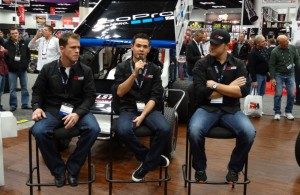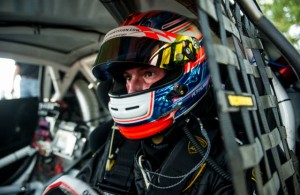Danny Kladis Passes Away At Age 92
- Updated: April 28, 2009
Danny Kladis, whose auto racing career dated back to the pre-World War II days of dusty race tracks and little driver safety equipment, passed away on April 26, at the age of 92. Kladis competed in the 1946 Indianapolis 500 and, prior to this death, was believed to be the oldest surviving “500” veteran.
Born in Crystal City, Mo., on February 10, 1917, Kladis had become a Chicago area resident when he got behind the wheel of a midget racing car for the first time around 1935. Kladis’ debut took place at Chicago’s 124th Field Artillery Armory-a hot bed of indoor racing during the pre-war years. With some 30-plus years of racing experience, Kladis’ career included his “500” participation, countless wins and championships in midgets, “big car” and sprint car battles and some stock car racing during that sport’s infancy in the Chicago area.
A 29-year-old Kladis drove for Andy Granatelli in the ’46 “500” classic, wheeling Granatelli’s rather old Grancor V8 Miller/Ford, but only completing 46 laps. Kladis was credited with a 21st place finish after starting in last place (33rd). Kladis’ first and only start in the “500” was a rather brief one as he was disqualified after the car was towed after it had stalled on the track. A quick inspection by his crew found that the fuel valve had been simply turned off.
Kladis returned to Indianapolis on and off for a period of about 10 years, but never made the starting field again. He did drive relief for Travis “Spider” Webb in 1954, but the team could do no better than a 30th place finish in Webb’s Advance Muffler entry. In 1957, Kladis made a qualifying attempt in the Morgan Engineering Special Maserati, but his time of 124.412 miles per hour was much too slow to make the race.
Earlier in his career, Kladis wheeled “big cars” on the old Central States Racing Association circuit in 1939 and 1940 and the following year tried his luck in AAA big cars. Competing in IMCA’s annual season-opening sprint car events in Tampa, Fla. In February of 1963, Kladis flipped and suffered a broken arm, a broken collarbone and a concussion. It was Kladis’ most serious injury since suffering a broken arm in an indoor crash at Chicago’s International Amphitheatre and a broken back in a midget spill at Chicago’s Raceway Park.
Most of Kladis’ success in racing came behind the wheel of a midget racing car. During the early part of his career, Kladis would just about drive anything, always looking to improve as far as equipment went. He teamed with Springfield’s Joe Shaheen and won his first midget feature race, piloting Shaheen’s Offenhauser-powered midget to the victory at Greenup, Ill. In 1940.
After World War II, Kladis joined forces with Wisconsin car owner Eric Lund and the combo enjoyed great success throughout the Midwest, especially in Iowa. Lund had both a Ford V8-powered midget and an Offy midget with Kladis often using the Ford V8 to beat some of the country’s best Offy-powered cars. The Kladis/Lund team garnered numerous wins and track championships. Kladis was named the Mississippi Valley Midget Racing Association champion in 1946, 1947 and again in 1948.
Raceway Park, located in the south suburbs of Chicago, was a short trek from Kladis’ home. On September 27, Kladis, behind the wheel of the Lund Offy, whistled around the speedway’s short quarter mile clay and brick dust surface in 14.40 seconds to set a new qualifying track record.
During the late 1940’s, Kladis entertained crowds at Raceway Park by putting on an exhibition of driving blindfolded around the racing oval. Kladis would tape silver dollars to his eyes and then cover them with a blindfold. Kladis would then power around the track at speeds just shy of a pure racing effort.
Racing into the 1970’s, Kladis was the United Auto Racing Association (UARA) driving champion in 1962. Wheeling Bob Lockard’s rapid-running Ford Falcon-powered mount, Kladis won 11 or so features racing during the ’62 season and defeated former UARA champion Ray Elliott and newcomer Henry Pens in the final standings. During the year, the UARA tour visited a number of Chicago area tracks with weekly Saturday night action taking place at the Joliet Memorial Stadium. Kladis captured the 100-lap UARA season finale on the dirt at Joliet in September of his title-winning year.
With the introduction of short track stock car racing taking place in Chicago in 1948, Kladis won the first-ever 300-lap stock car race at Raceway Park in late October. “Borrowing” a military Jeep from a local recruiting station, Kladis used the Jeep’s “four-wheel-drive” option to get the job done.
In addition to his racing career, Kladis also takes credit for “fine tuning” the engines for maverick billionaire and eccentric extraordinaire Howard Hughes’ famed “Spruce Goose” wooden airplane. An employee of the Ford Motor Company during the war, Kladis was a supervisor at the Ford plant on Chicago’s southside that built the powerful Pratt and Whitney Wasp R-4360 engines. Eight engines powered Hughes’ plane and Kladis claims that Hughes’ engineers and, sometimes, Hughes himself, would call him on the assembly line floor with questions about the mammoth engines.
For many years, Kladis was a pilot himself, doing both commercial and charter work, even flying jets for a number of major corporate accounts. In 2007, Kladis was inducted into the National Midget Auto Racing Hall of Fame. Kladis and his late wife, Mary Jean, raised a family, which included a son, George, who was the 1971 UARA champion.





![Porsche Fabcar crosses the finish line. [Robert Madara photo]](https://racingnation.com/wp-content/uploads/2023/11/FabcarFinish-108x70.jpeg)

![USF2000 Pro driver Lindsay Brewer. [Eddie LePine Photo]](https://racingnation.com/wp-content/uploads/2023/06/IMG_8825_2-108x70.jpg)